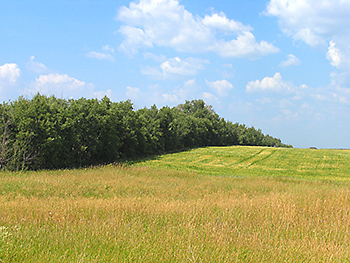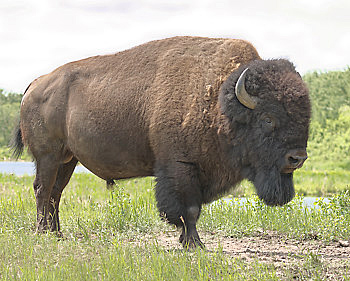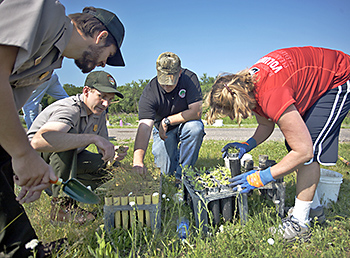The Agricultural Sector
The opportunities for ecosystem-level conservation are limited in the Agricultural South (Fig. 5.5) because most forms of agriculture, as well as urban development, entail permanent ecosystem transformation rather than transient disturbance. This precludes application of the natural disturbance model. Rangelands are an exception because native grasses are often retained to provide reliable forage in the dry regions where rangelands are concentrated.
Another challenge is that few levers exist for compelling farmers to act in the public interest. Most farmlands are privately owned, which provides farmers with strong legal rights over land management. Furthermore, the agricultural sector has considerable political influence at both the federal and provincial levels. Finally, the family farm has a special place in Canadian culture and is strongly supported, even though an increasing number of farms are being sold to corporations and investors. Thus, farming has been largely immune to pressure from environmental groups.
Because of these limitations, conservation measures in the Agricultural South are largely implemented on a voluntary basis, and direct coercion is rarely applied. For example, despite the federal Fisheries Act and Migratory Birds Convention Act, and various provincial water acts, farmers continue to drain ecologically important wetlands with impunity (Cortus et al. 2011). That said, many farmers have an intrinsic stewardship orientation and will work cooperatively with governments and conservation organizations to achieve specific conservation outcomes (Olive and McCune 2017). These efforts usually target components of the landscape not directly needed for agricultural production.
Environmental sustainability is mentioned in the Guelph Statement (FPTMOA 2021), which articulates the current policy vision of the federal and provincial Ministers of Agriculture. However, no conservation framework exists comparable to what has been produced for the forestry sector. Conservation efforts are planned and delivered through collaborative efforts involving federal and provincial agricultural ministries, agricultural producers, and a variety of non-governmental organizations, such as Ducks Unlimited Canada, the Nature Conservancy of Canada, and smaller community groups. Provincial wildlife departments are also involved, though most of their efforts are focused on focal species (which happen to be concentrated in the Agricultural South). Conservation in the agricultural zone is also supported through research at centres across the country.
Ecosystem-level conservation efforts in the Agricultural South include habitat protection (discussed in Chapter 8), the development and use of agricultural best practices, habitat restoration, and the application of the natural disturbance model in rangelands.
Agricultural Best Practices
In areas of active agricultural production, conservation efforts are generally opportunistic rather than target based. The aim is to reduce environmental harm as much as possible through agricultural best practices. These are farming methods that are beneficial to the environment while also being economically viable (Hilliard et al. 2002). The goal of maintaining ecosystems within NRV is only achievable in rangelands and protected areas.
Outreach efforts to farmers are funded and delivered through programs run by governments and various non-governmental organizations. The logistics are challenging. Advancing conservation in the Agricultural South entails interacting with over 200,000 individual farm owners.
The most extensive programs related to the development and promotion of agricultural best practices are run by provincial governments, in collaboration with the federal government. These initiatives tend to use ecosystem services as a conceptual framework (see Chapter 4), and this is reflected in the selection of issues and practices. Best practice guidelines typically include the following categories (Hilliard et al. 2002):
- Nutrient management: precision application of fertilizer and control of manure storage and spreading
- Pesticide management: precision application of pesticides and integrated pest management
- Soil management: conservation tillage and perennial cover programs in high-risk areas
- Riparian management: livestock fencing and seasonally restricted grazing
- Wetland management: natural buffers around wetlands and wetland retention
- Shelterbelts: planting of shelterbelts to control erosion and retain winter moisture (Fig. 7.10)
- Irrigation management: Variable rate irrigation to conserve water and minimize salinization

In most provinces, agricultural best practices are promoted through farm stewardship programs that include government outreach, technical support, and financial incentives. To qualify for technical support and funding, farmers must first complete an Environmental Farm Plan, which identifies environmental risks from farming operations and actions to mitigate these risks (BCARDC 2021). Under this federal-provincial program, farmers can receive funding to implement qualifying best practices on a cost-share basis.
The best practices included in provincial stewardship programs focus mainly on water and soil, but there are also best practices that relate directly to biodiversity. These practices are designed to maintain as much structural and compositional diversity as possible across the farm landscape (Martens et al. 2013). Examples include:
- Maintain as much perennial cover as possible
- Re-establish and retain natural vegetation, particularly in riparian areas, wetland buffers, shelterbelts, along fence lines, and in remnant patches of forest
- Diversify cropping systems by rotating through different crop types
- Diversify grazing patterns, varying from heavy to light intensity and varying the annual timing of grazing
- Use native grass species in pastures
- Use organic approaches to fertilization and pest control rather than chemical approaches
Programs to support the implementation of biodiversity-oriented best practices are still nascent. An example is the Alternative Land Use Services (ALUS) initiative, which began in Manitoba in 2006 and has since spread to five other provinces (Schmidt et al. 2012). ALUS is a community-led charitable organization whose mission is to help farmers and ranchers build nature-based solutions on their land to sustain agriculture and biodiversity.
ALUS initiatives are implemented on marginal and fragile land on working farms. Participating farmers restore wetlands, reforest native trees and shrubs, plant windbreaks, install riparian buffers, manage sustainable drainage systems, create pollinator habitat, and establish other ecologically beneficial projects on their properties. The intent is to make the most of marginal spaces on farmland, while leaving the better sites for food production. Farmers are responsible for implementing the conservation measures and they receive an annual payment for doing so. Remuneration is based on established cropland leasing rates. Funding partners include a mixture of government, corporate, foundation, ENGO, and community donors. As of 2023, 1,421 farmers had enrolled 15,255 ha in ALUS programs, supported by annual distributions of $4 million (ALUS 2023).
Although initiatives like ALUS are promising, they are constrained by insufficient funding and formidable logistic challenges. The farms enrolled in the ALUS program represent just 0.6% of Canadian farms. It is not that money is lacking; federal and provincial governments spend over $1 billion each year supporting farming in Canada (GOC 2022a). The issue is how farm subsidies are allocated. Kenney et al. (2011) note:
Over the past two decades, a growing number of studies have highlighted how some government subsidies can serve as a powerful disincentive to sustainability by encouraging overuse and waste of scarce natural resources and placing additional stress on the health of ecosystems. Some subsidies to agriculture encourage agricultural intensification and expansion by either directly tying the level of payments to production levels, or by decreasing the costs of inputs (such as fertilizers and pesticides). … One obstacle to reforming agriculture subsidies is the perception that they predominantly support small family farms and a traditional way of life. The reality, however, is quite different: a 2003 study found that the majority of the subsidies in OECD countries were captured by larger and wealthier producers, which also tend to use more intensive farming practices. (pp. 35–38)
The upshot is that, despite the inviolability of private landowner rights, policy mechanisms exist for promoting conservation on agricultural lands. However, they involve high-level budgets which are politically volatile. In the absence of strong public pressure, which is what transformed the forest industry, change is likely to be slow.
The Natural Disturbance Model in Rangelands
The prospects for biodiversity conservation are much greater in rangelands than in other agricultural areas because grazing is compatible with the natural disturbance model. Moreover, substantial amounts of native prairie remain within rangeland areas, and a large proportion of these lands are still publicly owned (Bailey et al. 2010).

Historically, fire and bison grazing were the dominant forms of disturbance in grassland systems and there was an important interaction between them: fire altered grazing behaviour, and grazing altered the extent and intensity of fires (Fig. 7.11; Fuhlendorf et al. 2006). Together, these processes generated a shifting mosaic of patch types, analogous to what we discussed in forest systems (Anderson 2006).
The application of the natural disturbance model to rangelands involves the use of prescribed fire and cattle grazing to emulate the effects of wildfire and bison grazing, which are now largely absent (Fuhlendorf et al. 2012; Freese et al. 2014). Prescribed fire is already used for brush control, so ranchers have some familiarity with it. Cattle grazing can be used to approximate natural grazing, but the intensity and timing of grazing need to be varied (Bailey et al. 2010). As with forestry, NRV should guide decision making about the timing, intensity, and spatial distribution of managed activities.
In practice, application of the natural disturbance approach to range management lags far behind its application in forestry. Most of the applied research and outreach has occurred in the US (Weir et al. 2013). In Canada, the approach has only been applied in protected areas that have a mandate for maintaining ecological integrity (PC 2008). Outside of parks, range management guidelines often include biodiversity conservation as a desired outcome but make no mention of NRV or the emulation of natural disturbances (Bailey et al. 2010). Practices generally remain focused on sustaining range productivity, implicitly assuming that biodiversity will be maintained by default.
Despite the current lack of implementation, the natural disturbance model still holds promise for range management. Feasibility is actually higher here than in the forestry sector because there are fewer land-use conflicts. The main impediment is funding. As previously noted, it is not realistic to expect ranchers to pay for expensive measures like prescribed fire just because they are in the public interest. New economic instruments will be needed for progress to be made. Also, greater awareness is required within the ranching sector about the natural disturbance approach and its value in conserving biodiversity.
Restoration
Restoration is the process of assisting the recovery of an ecosystem that has been degraded through human activities (SERI 2006). The term “restoration” denotes an intent to return a site to its natural state, whereas the related terms “reclamation” and “rehabilitation” refer to the repair of damage, without necessarily recreating the original ecosystem (Hobbs and Cramer 2008). In this section, we focus on restoration, which is most commonly applied in the agricultural zone. We will discuss reclamation in a later section, in the context of decommissioning mining and oil and gas projects.

Restoration projects are led by a wide variety of organizations, from national groups like Ducks Unlimited and the Nature Conservancy, to local stewardship groups and municipal governments. Provincial and federal governments tend to engage as partners and funders rather than as project leaders. Most initiatives are collaborative and often involve the participation of volunteers (Fig. 7.12). Funding is typically provided by the lead groups or is obtained through government and foundation grants. For example, under the Greencover Canada program, the federal government provided $110 million over five years (2003–2008) to fund the conversion of environmentally sensitive farmland to perennial cover (AAFC 2003).
Restoration is expensive and funding is limited. Therefore, it is not a tool that can be applied to all degraded landscapes. Efforts are generally focused on sites with high conservation importance, including ecosystems that have become very rare, habitat for species at risk, and landscapes needed to achieve connectivity objectives. Wetlands that have been drained or degraded through agricultural practices are an example (Tori et al. 2002). The protection and restoration of Canada’s wetlands has been a major focus of the North American Waterfowl Management Program since its inception in 1986 (NAWMPC 2012). Remnants of Carolinian forest (Thompson 2011) and native prairie (McLachlan and Knispel 2005) are also common targets for restoration.
Other considerations in site selection include the potential for success (given available funding) and the risk of future degradation. The mandate and priorities of the lead groups and stakeholders are also important. It is no coincidence that Ducks Unlimited works primarily on wetlands.
Another common application of restoration is to return protected areas to a more natural state by reversing changes that occurred prior to their establishment (PC 2008). For example, agricultural fields and orchards accounted for 40% of Point Pelee National Park in southern Ontario in the 1950s, and the site was riddled with hundreds of cottages and access roads. Through a combination of passive and active restoration efforts over several decades, most cottages and roads have been removed and there has been progressive replacement of alien vegetation with native species (McLachlan and Bazely 2003).
In most restoration projects, the emphasis is on restoring the native plant community. It is assumed that native fauna will passively follow once the appropriate vegetation is in place (Hobbs and Cramer 2008). Projects begin by defining the objectives of restoration. The desired endpoint may be complete restoration, but this is usually tempered by practical realities. Restoration efforts are subject to diminishing returns, and the difference in cost between complete restoration and “good enough” may be exponential (Cowan et al. 2010).
It is also necessary to characterize the ecological reference state that will guide restoration efforts. A comparable ecosystem that is still largely intact is often used for this purpose (McLachlan and Knispel 2005). However, new approaches are being contemplated to accommodate global warming (see Chapter 9).
Sometimes, restoration can be achieved through simple passive measures that prevent further degradation but otherwise allow the system to recover on its own through natural processes. In other cases, barriers may exist that interfere with the recovery process. Biotic barriers, such as competition from agronomic species and weeds, are common (McLachlan and Knispel 2005). There can also be abiotic barriers, such as changes in hydrology and increased nutrient levels from fertilizer application (Hobbs and Cramer 2008).
The nature of these barriers, together with capacity constraints, guide the development of restoration strategies. Though generic restoration guidelines are available, such as those produced by Parks Canada (PC 2008), specialized expertise is often required. A significant amount of trial and error learning may also be needed for adapting generic restoration techniques to individual sites (Cabin 2007). In most cases, time and perseverance are critical ingredients of success. Larger projects often require years of sustained effort (Hobbs and Cramer 2008).

